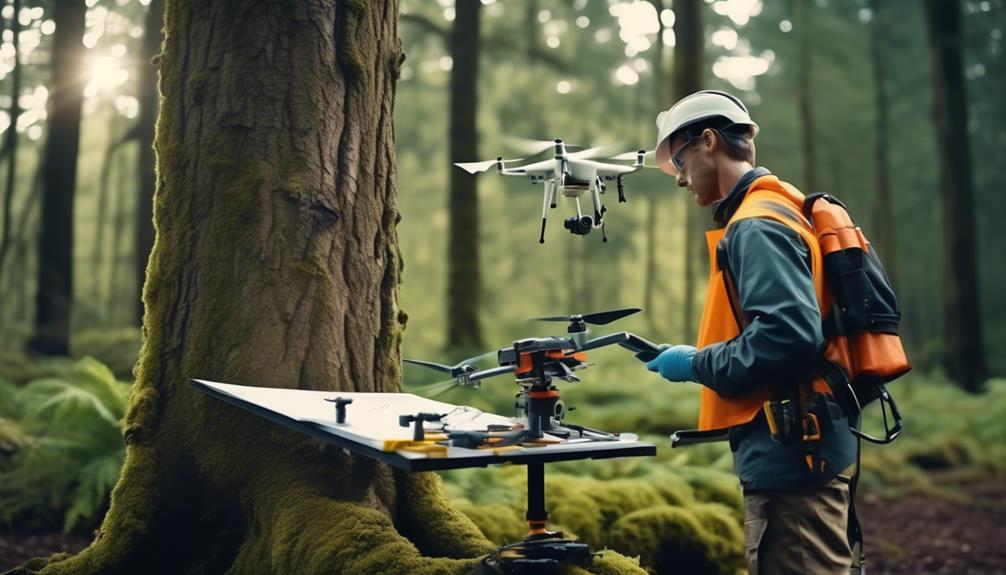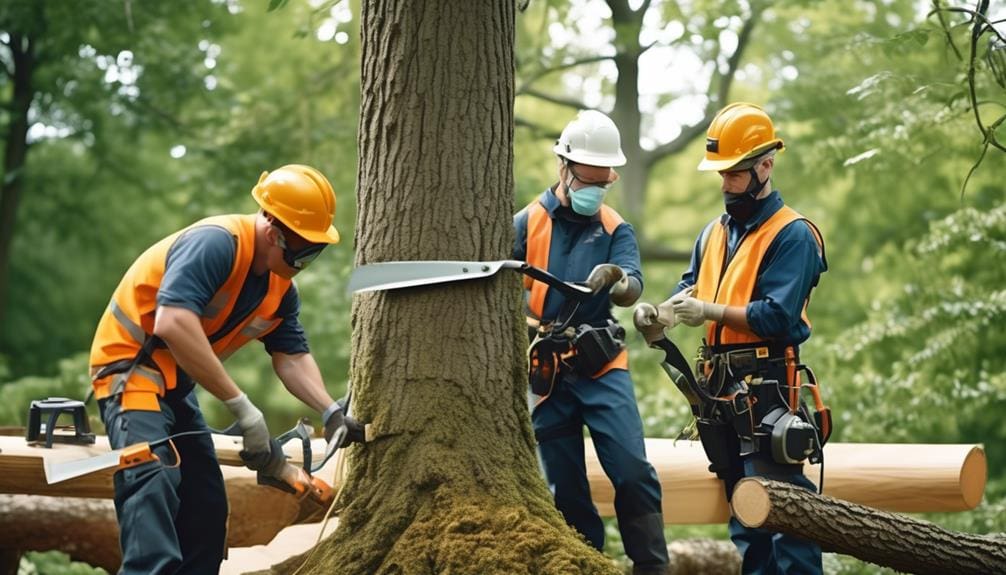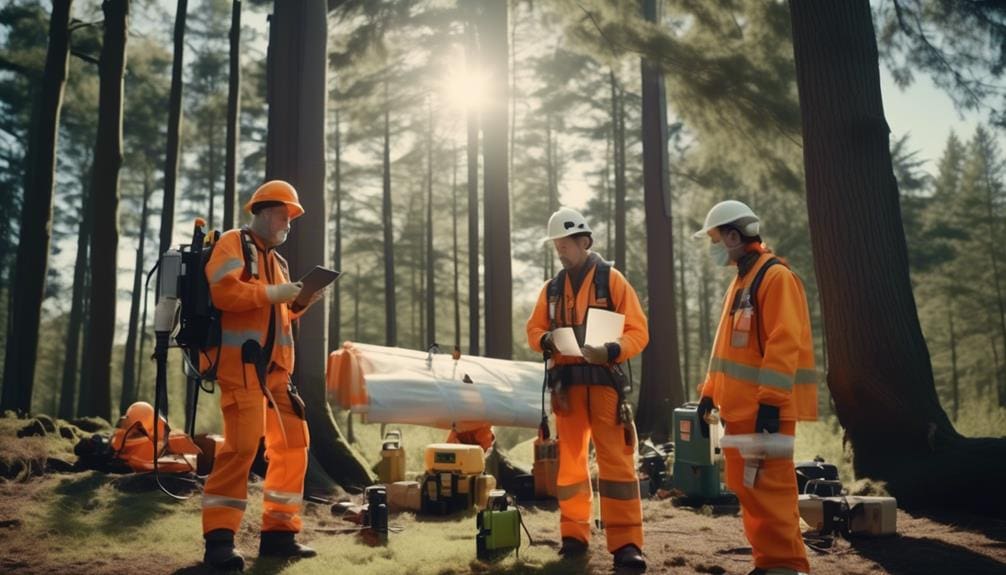Tree Health and Maintenance
Safe Tree Cutting: OSHA’s Top 6
Much like Odysseus navigating the perilous strait between Scylla and Charybdis, we in the tree cutting industry must steer a careful course between productivity and safety.
We’ve all heard the harrowing tales of accidents that could have been avoided with proper precautions, which is why OSHA’s top six guidelines for safe tree cutting are critical lifelines for our work. These regulations are our map to safe harbor, ensuring that each member of our team is equipped with the necessary knowledge and tools to perform their duties without falling prey to the myriad hazards that our profession presents.
We understand the gravity of these risks and the importance of adherence to these standards. Yet, there’s more to the story than simply listing out regulations; it’s about understanding the rationale behind them, the real-life implications, and the nuanced challenges we face in implementing these safety measures effectively.
Join us as we embark on a journey to dissect these guidelines and unearth the strategies that will keep our team members both safe and efficient in the canopy of challenges above.
Key Takeaways
- OSHA regulations govern tree-cutting operations, and adherence to these regulations is crucial for compliance and safety.
- Personal protective gear, such as hard hats, eye and hearing protection, gloves, chainsaw chaps, slip-resistant boots, and full-body harnesses, enhances safety in tree-cutting operations.
- Comprehensive hazard assessment procedures, including site surveys and assessment of tree condition and surrounding environment, are essential before tree cutting.
- Training and certification in arboriculture or related fields are mandatory for the safety of tree trimmers, and they include education on safe climbing techniques, proper tool usage, hazard recognition, and electrical safety precautions.
Understanding OSHA Regulations
To ensure the safety of tree-cutting operations, it’s essential to grasp the OSHA regulations that govern this high-risk activity. We’re committed to maintaining an environment where our freedom to work is harmonized with uncompromised safety standards.
Tree trimming requires meticulous adherence to OSHA’s guidelines, which mandate the use of protective equipment, including hard hats, eye protection, and safety harnesses for fall protection.
We recognize that these regulations aren’t just bureaucratic hurdles but vital measures that protect our lives. By following these protocols, we’re not only compliant but also safeguard our right to return home unharmed.
It’s our shared responsibility to be well-informed and equipped, ensuring every tree-cutting task is performed safely and efficiently.
Personal Protective Gear
Building on our understanding of OSHA regulations, we now focus on the critical role that personal protective gear plays in enhancing the safety of tree-cutting operations.
When trimming tree limbs, the right gear isn’t just recommended, it’s essential. We always don head protection, eye and hearing protection, and sturdy gloves—these are the basics of our defense against common hazards.
Chainsaw chaps or protective pants become our second skin, shielding our legs from the high risks of kickbacks.
We’re firm on footing with slip-resistant boots, a must for navigating the unpredictable terrain.
And for those jobs that take us above ground, we’re secured in full-body harnesses, part of a reliable fall protection system.
We don’t overlook face shields, respiratory protection, or high-visibility clothing either, as these additional personal protective gear items keep us safe and sound in various working conditions.
Hazard Assessment Procedures


Before we commence any tree cutting task, we must first pinpoint potential risks through comprehensive hazard assessment procedures.
We’ll conduct thorough site surveys to identify dangers, from power lines to unstable trees, ensuring our team’s safety throughout the operation.
It’s crucial we equip our personnel with the necessary personal protective equipment to mitigate the risks we uncover.
Identifying Potential Risks
How can we ensure the safety of tree cutting operations?
Conducting a thorough hazard assessment beforehand is crucial for identifying potential risks. We must assess both the condition of the tree and the surrounding environment. This includes spotting unstable branches, proximity to power lines, and potential obstacles. We’re aware that weather conditions, like wet or windy weather, can significantly increase the hazards of trimming trees, and we adjust our work plans accordingly.
We prioritize safety by determining the necessity for personal protective equipment and appropriate climbing gear for each job. Furthermore, we’re committed to inspecting and maintaining our equipment regularly.
These steps are vital to guarantee a safe and efficient operation when tackling the task of cutting or trimming trees.
Conducting Site Surveys
Having identified potential risks, we’ll now conduct a comprehensive site survey to further ensure the safety of our tree cutting operations. We’ll meticulously assess the work area for overhead power lines or other electrical hazards that could jeopardize our team during tree trimming. Our focus will be on spotting unstable trees, weak branches, and any structural weaknesses that present dangers to our workers.
We’ll also consider environmental factors, such as weather conditions, that could affect our operation’s safety. It’s vital we communicate with utility companies or relevant authorities to de-energize or insulate power lines near our work site. This proactive coordination is crucial for maintaining a safe work environment and upholding the freedom and well-being of everyone involved.
Personal Protective Equipment
As we proceed with tree cutting operations, it’s essential that we conduct a thorough hazard assessment to determine the appropriate personal protective equipment (PPE) required for the safety of our team. The freedom to work without undue risk is paramount, and our commitment to safety reflects this value. Here’s what we prioritize:
- Conducting comprehensive hazard assessments to identify risks
- Selecting PPE that specifically addresses the assessed hazards
- Inspecting and maintaining PPE to ensure peak performance
- Training our workforce in the correct use and limitations of their PPE
Adhering to these steps ensures that we not only comply with regulations but also empower our team to work confidently and safely. It’s our responsibility to equip our personnel with the knowledge and tools they need to protect themselves from harm.
Training and Certification


We recognize that comprehensive training and certification are paramount for the safety of tree trimmers.
Our discussion will cover the essential criteria for certification, the core components of an effective training program, and the methods for validating safety skills.
Ensuring our teams meet these standards is critical for compliance with OSHA’s guidelines and the prevention of workplace accidents.
Certification Requirements
To ensure the safety and proficiency of tree trimming professionals, certification in arboriculture or related fields is a mandatory requirement. This certification process equips workers with the essential skills and knowledge to perform their tasks effectively while adhering to safety standards.
We recognize the critical importance of comprehensive training on safe climbing techniques and proper tool usage. Education on hazard recognition and electrical safety precautions is also crucial. Additionally, skill development for assessing tree health and identifying potential risks is essential. Specialized instruction for operating aerial lifts and chippers safely is also necessary.
We’re committed to fulfilling OSHA’s mandates, providing our employees with the necessary certification and training. By doing so, we safeguard not only our workers but also the community at large, ensuring freedom from avoidable accidents and injuries.
Training Program Essentials
Building on the foundation of certification requirements, our training program essentials encompass both the acquisition of critical skills and the verification of safety competencies for tree trimmers. We’re committed to ensuring our team is well-versed in safe climbing and cutting techniques, as well as adept in the proper use of gear and equipment. Our certification process is rigorous, confirming that each tree trimmer has mastered the necessary training and can perform operations safely.
We also prioritize ongoing training to keep our crew abreast of the latest safety protocols and industry advancements. Education on electrical safety, hazard recognition, and tree trimming-specific safe work practices is integral to our program. We’re dedicated to fostering a culture of safety that empowers our team to work with confidence and freedom.
Safety Skills Validation
Ensuring our arborists’ proficiency in safe tree cutting is a top priority for us. That’s why we have implemented our Safety Skills Validation program, which combines rigorous training with comprehensive certification. This dedication to excellence guarantees that our team isn’t only skilled but also operates within the bounds of regulatory compliance, thereby safeguarding their personal freedom to work without undue restriction.
Key components of our program include:
- Hazard Recognition: Identifying potential risks before commencing work.
- Safe Climbing Techniques: Ensuring secure movement in and around trees.
- Equipment Operation: Mastery of tools necessary for safe and efficient cutting.
- Emergency Procedures: Preparedness to handle unforeseen situations effectively.
We’re committed to maintaining a safe work environment and ensuring that our arborists are equipped with the knowledge and tools they need to perform their duties freely and safely.
Emergency Response Planning


Crafting a robust emergency response plan is crucial for the safety of workers during tree cutting operations. This plan encompasses immediate actions for medical crises and power line accidents. We ensure that every team member is trained on this plan, recognizing the diverse scenarios they might face. It’s essential that our workers know exactly how to react swiftly and effectively.
We’ve put emergency communication systems in place, like walkie-talkies or cell phones, so help can be summoned without delay. We’ve also identified emergency assembly areas, providing a clear rendezvous point in case of an incident.
Regular reviews and updates of our emergency response plan keep it current, reflecting any changes in our team, equipment, or the environment we work in. We’re committed to a workplace that prioritizes rapid and effective emergency responses.
Equipment Maintenance Checks
We rigorously inspect and maintain our equipment, from chainsaws to aerial lifts, to guarantee their safe operation for every tree cutting task. This meticulous attention to detail ensures that all our tools and machinery are up to the task, providing our team with the freedom to work without the worry of equipment failure.
To stay compliant and precise in our approach, we adhere to the following maintenance checks:
- Regular inspection and upkeep of chainsaws and trimmers for safe operation
- Routine checks on aerial lifts and chippers to confirm proper function and defect-free status
- Examination and maintenance of fall protection gear, including harnesses, ropes, and lanyards
- Assessment and care of all access gear such as ladders for secure use
Each check is a step towards ensuring a safe and efficient work environment.
Conclusion
We’ve covered OSHA’s crucial guidelines for safe tree cutting, emphasizing the importance of proper gear, hazard assessments, and regular training.
By adhering to these protocols and ensuring equipment is well-maintained, we’re not only complying with regulations but safeguarding our team’s well-being.
Let’s commit to these practices, stay vigilant, and always be prepared for emergencies.
Safety isn’t just a standard; it’s our collective responsibility when working at heights, near power lines, and alongside roadways.
Together, we can keep every job site secure.


Hello there! I’m Logan Foster, the green-thumbed social media marketer behind the vibrant world of 1800TreeGuy.com. With roots firmly planted in arboriculture, I’ve branched out to help clients cultivate their dream outdoor spaces, one leafy canopy at a time. My knack for nurturing nature is more than a profession—it’s a way of life.
When I’m not talking trees and teaching the art of arboreal care, you can find me cheering on the Bulldogs—my alma mater’s pride and my forever team. My environmental studies there didn’t just teach me about ecosystems; they instilled a lifelong passion for protecting our planet.
Off the clock, I’m an adventurer at heart. Whether it’s trekking the Appalachian trails, pedaling down a mountain path, or crafting guides to share the wonders of the wild, I’m happiest with soil under my nails and the sun on my face. And let’s not forget Yoda, my pug sidekick. He may not have mastered the art of stillness, but his joyful grins are my daily dose of happiness.
I’m all about making connections—between people and the great outdoors and between my clients and their ideal landscape visions. My approach is personal; every tree has a story, and every garden reflects its caretaker.
If you want to green your scene or share in my outdoor escapades, give me a shout on Instagram or Facebook. Let’s cultivate a conversation and grow a community rooted in a love for the lush life.















